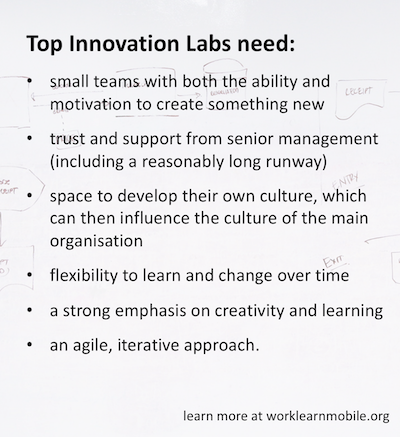
Articles
Innovation Labs: embedding enterprise innovation
by Geoff Stead

Is your organization innovative enough?
The ultimate innovation challenge in business is how to balance two opposing forces: Allowing the freedom to innovate while at the same time managing business as usual. Sadly most large organizations fail to keep these in balance. They fail to innovate themselves, but at the same time fail to successfully import innovation from others
How can innovation labs help?
Innovation labs are small, embedded teams set up to explore new business models, products or ideas. For some businesses, these labs are about chasing the next great product whereas for others they serve an internal improvement function, seeking to improve employee performance, management systems and client focus.
At Qualcomm I was running a mobile learning innovation lab of 15 technologists embedded inside the corporate HR function where our role was a mix of internal (helping all employees perform better at work) and external (showcase mobile innovation to partner companies). As part of this we worked with great businesses like Google, Twitter, Microsoft, Facebook, GE, HP and Nike to explore how mobile could support internal learning innovation.
We were an internal innovation lab. We were lucky to partner with other, similar labs too. These are the models that seem to appear most often:
1.Build: develop an internal innovation lab
This is probably the most likely to lead to long-term business benefit because stakeholders are well aligned to the business, but this alignment can also be a hinderance. To succeed, these labs need enough separation from the rest of the business to be allowed to develop their own culture, with freedom to challenge the status quo. Good examples are 3M, Apple, Amazon Lab126, Google X, HP Labs, Microsoft Research Lab, Xerox Parc and Lockheed Martin (the original skunkworks).
This is what we did at Qualcomm. it is also what I went on to do in a 150 year old business owned by Cambridge University. It isn’t straightforward though, as your business needs the bravery to support quite diverse teams and methods.
2.Buy: acquire an innovative smaller business, and being them in
Unfortunately the technology press is filled with examples of this going badly wrong. First, the headline when a larger business buys a small innovator for an eye watering price, and the sad follow up when they manage to kill the very essence they were hoping to absorb.
This can work, but it requires a very honest assessment on why they were acquired (IP? Acquihire? customers?), and if it is about the people, then an obsessive focus on preserving the culture.
3.Partner: forming a tight alliance with external teams to learn from them
There are many examples of larger businesses nurturing smaller startups for mutual benefit. The theory is that the smaller startup brings new energy and ideas, while the larger one increased access to new markets. BBC famously host exciting small media businesses for the purpose of enthusing their own employees. Sadly, though, recent research seems to show that the smaller startups don’t always benefit as much as the big guys do.
A variation of this that worked really well for us at Qualcomm was to identify smaller, emerging startups that were doing innovative work we could benefit from, and pre-licensing from them. Prepaying for an as yet unfinished product. We would be included in co-designing of the product, but we were never more than a keen customer, so unable to meddle too much. We did this with several small learning technology companies with huge benefits on both sides. One team was Pathgather. I think we were their first big customer. We helped them pivot into the corporate space, and built a great relationship along the way
Another variant of this is a tight university partnership. In Cambridge we sponsored 15 Phd’s in related areas at the University, as well as funding ALTA, shared R&D institute. By sharing data with the researchers, we benefit from improved insights, and help inventing future products. Stanford University has a strong history of partnerships like this (e.g. Volkswagen and VAIL)
SO WHAT WORKS?
At WorkLearnMobile we’ve been involved in several large labs projects, and whichever approach you go for, these seem to be the main requirements for success.
Top Innovation Labs need:
- small teams with both the ability and motivation to create something new
- trust and support from senior management (including a reasonably long runway)
- space to develop their own culture, which can then influence the culture of the main organisation
- flexibility to learn and change over time
- a strong emphasis on creativity and learning
- an agile, iterative approach.
Are you in an innovation lab? Do these fit with you experience? Anything we missed?
We believe if you can get these right, you’ve got much higher chance of success.
Happy innovating!
